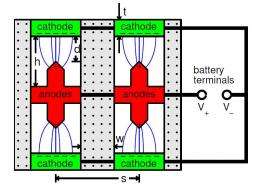January 28, 2010 report
Digital quantum batteries inspired by plasma TVs

(PhysOrg.com) -- Plasma TVs are notorious for their excessive use of electricity, but the same principle used to produce high definition pictures in the TVs could result in the development of a new type of battery that would save rather than waste energy.
Plasma TVs contain millions of microtubes filled with ionized gas that allows an electrical current to flow through, but physicists at the University of Illinois at Urbana-Champaign (UIUC) are developing what they call a "digital quantum battery" that uses billions of even smaller tubes (nanotubes).
By removing the ionized gas from the tiny tubes, the UIUC team, led by Associate Professor Alfred W. Hubler, wants to take advantage of the strong electrical fields to store electricity. When the gas is removed the vacuum inside the nanotubes acts as an insulator to store the electrical field. Professor Hubler says the device could store twice as much electricity as conventional batteries, and it could store digital information at the same time.
The battery is termed the digital quantum battery because it operates on the quantum scale, trapping the strong electrical field generated when negatively charge electrons encircle positively charged protons inside an atom. The device harnesses the most effective way to store energy, which is in the bonds between atoms. (The energy in gasoline and kerosene is held in the same way.)
The battery’s reverse-bias nanotubes are much stronger and smaller than plasma tubes and they contain little or no gas. Hubler said the tubes would be five nanometers long and billions of them would be packed together to provide enough power for most 15 V electronic devices.
Each nanotube could also represent a bit of information (0 or 1, depending on whether the tube is electrically charged or not). This means the device could be used to store digital information like a flash drive. Hubler said a flash drive uses the smallest amount of energy to store the charge, while the UIUC device would aim for the maximum possible amount of energy.
The state of the vacuum tube can be determined without discharging or charging it because a MOSFET (metal-oxide-semiconductor field-effect transistor) is inserted in the wall of the tube to detect the state inside the tube. Each tube has an energy gate and an information gate, which is a similar arrangement to the floating and control gates in a flash drive. The gates allow the nanotubes to be used to store information and energy.
Professor Hubler is the Director of the Center for Complex Systems Research at UIUC. The research paper will be published in the journal Complexity, for which Professor Hubler is an executive editor. The work was supported by a National Science Foundation Grant.
More information: Paper: netfiles.uiuc.edu/a-hubler/www … quantumbatteries.pdf
© 2010 PhysOrg.com
















